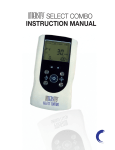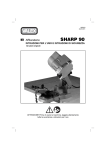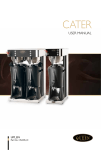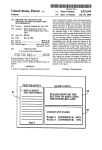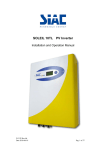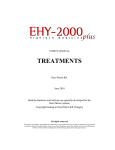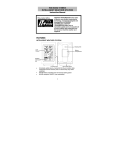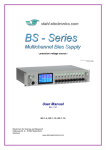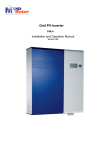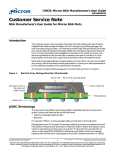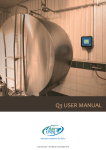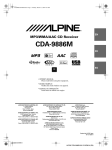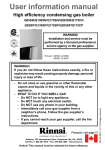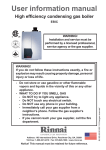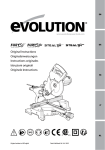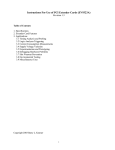Download Milkguard FD (US version)
Transcript
Index symbols Buzzer on LED’s blinking green / red Buzzer on / off LED’s blinking green Buzzer off LED’s continuous green Enter button LED’s blinking red LED’s continuous red Page – 2 User Manual DairyCheq MilkGuard V4.2 – 06-2007 Preface Thank you for purchasing the DairyCheq MilkGuard and the confidence you have in our Company. Optimum performance, high reliability and a long life are the design requirements applied to all DairyCheq products. The DairyCheq MilkGuard has been designed first and foremost for the universal use on various types and sizes of milk cooling tanks for monitoring the milk storage. This manual has been made for the end-user of the DairyCheq MilkGuard. The producer instructions are included in this manual. The manual aims to assist you, the end-user, in using your DairyCheq MilkGuard. The quick reference card included in the appendix is a summary of the hands-on operation, while this manual provides more substantial information on the operation and maintenance of the DairyCheq MilkGuard, as well as the safety instructions that come with it. Please remember: Display the Quick Reference Card DairyCheq MilkGuard clearly visible in the vicinity of the MilkGuard Keep this producer manual in a dry location in the vicinity of the MilkGuard for quick reference. User Manual DairyCheq MilkGuard V4.2 – 06-2007 Page - 3 of 37 Table of Contents: H1 Introduction ................................................................................................................... H2 Safety ............................................................................................................................ 2.1 General ............................................................................................................ 2.2 Warnings.......................................................................................................... 2.2.1 Monitoring the temperature ................................................................ 2.2.2 Monitoring the agitator........................................................................ 2.2.3 Switch-on alarm.................................................................................. 2.2.4 General conditions ............................................................................. 2.2.5 Tank cleaning indication..................................................................... 2.2.6 Pipe cleaning indication...................................................................... 2.2.7 Monitoring the overall operation......................................................... 2.2.8 Power Interruption .............................................................................. 2.2.9 Remaining alarms .............................................................................. 2.3 Information....................................................................................................... 2.3.1 Data last cleaning process ................................................................. 2.3.2 Data tank load .................................................................................... 2.3.3 Data milking time................................................................................ 2.3.4 CRITICAL alarms of the present tankload ......................................... 2.3.5 All alarms in the last month ................................................................ H3 Safety ............................................................................................................................ H4 Transport and storage................................................................................................... H5 Operation ...................................................................................................................... 5.1 Information screens ......................................................................................... 5.1.1 Data latest cleaning............................................................................ 5.1.2 Data tank load .................................................................................... 5.1.3 Time information................................................................................. 5.1.4 Data milking times .............................................................................. 5.1.5 CRITICAL alarms of the present tank load ........................................ 5.1.6 All alarms in the latest month ............................................................. 5.2 Changing the producer preferences ................................................................ 5.3 Tank collector driver ........................................................................................ H6 Maintenance ................................................................................................................. H7 Troubleshooting ............................................................................................................ H8 Scrap............................................................................................................................. 5 7 7 9 10 13 15 16 17 19 21 24 24 24 25 25 25 26 26 27 27 28 28 28 28 29 29 29 29 30 32 33 33 33 Appendices: A. Producer preference settings....................................................................................... 35 B. Quick reference card MilkGuard .................................................................................. 36 C. Technical specifications ............................................................................................... 37 Page – 4 User Manual DairyCheq MilkGuard V4.2 – 06-2007 H1 - Introduction The DairyCheq MilkGuard has been designed to monitor the storage of milk on the farm in a milk cooling tank. No matter what type or size the tank may have, the DairyCheq MilkGuard will monitor the storage conditions of the milk. The DairyCheq MilkGuard is a tool for the producer to help him supply consistently high-quality milk from his farm. It is also an excellent tool for the buyer of the milk (the dairy company) to realise the highest possible quality of the milk collected. The DairyCheq MilkGuard monitors, among other things, the temperature conditions of the milk during storage, the agitation process in the tank, as well as a number of cleaning conditions during the tank and pipe cleaning process. First and foremost the DairyCheq MilkGuard has been designed to monitor the storage of milk in a milk cooling tank on the farm. The area must be clean and dry. Do not clean the DairyCheq MilkGuard using running water or high-pressure water. Any use of the DairyCheq MilkGuard, other than described in this manual, is strictly prohibited due to possible unforeseen hazardous situations. The DairyCheq MilkGuard is designed for indoor use only. The area in which the DairyCheq MilkGuard is being used must be properly ventilated, clean and free of dust, caustic and corrosive gases and substances, with an air humidity between 10 and 90% and a temperature between 14ºF and 104ºF. Powersupply must also meet the specifications shown in appendix C at any time. If the equipment is used in a manner not specified by the manufacturer, the protection provided by the equipment may be impaired. The manufacturer will not assume any liability for adjustments or modifications made to the operation, principle or controls of the DairyCheq MilkGuard. The person(s) making such changes will be fully responsible for the consequences of their actions. Any form of claim under warranty and manufacturer liability is excluded if all or any of the above terms and conditions are not adhered to. The producer will remain responsible for the storage of milk in the tank and consequently for the quality of the milk at all times. That is the reason why you should appropriately act on every fault message from the DairyCheq MilkGuard, check the temperature of the milk after every milking cycle, and visually inspect the cleanliness of the inside of the tank after every cleaning cycle. User Manual DairyCheq MilkGuard V4.2 – 06-2007 Page - 5 of 37 Page – 6 User Manual DairyCheq MilkGuard V4.2 – 06-2007 H2 - Operation 2.1 - General: Key functions: User Manual DairyCheq MilkGuard V4.2 – 06-2007 Page - 7 of 37 Display structure: Display structure when no alarms are activated: Current date and time Current temperature of the milk: Large print means “no active alarms” Display at activated, unacknowledged alarm: Description of the active alarm Starting time and duration of the active alarm Active alarm symbol: Flashing: critical alarm Solid: producer alarm Page – 8 Critical alarm symbol: Flashing: unacknowledged critical alarm Solid: acknowledged active critical alarm User Manual DairyCheq MilkGuard V4.2 – 06-2007 2.2 - Warnings: The alarms on the screen are displayed in the following manner: The MilkGuard warns for several incorrect situations. The MILKGUARD splits the alarms into two main categories: CRITICAL ALARMS are warning for situations that could jeopardise the quality of milk. producer alarms, warning the producer to prevent any CRITICAL alarms. These groups are having the following properties: Display LED Warning symbol Alarm text Category symbol Colour during the alarm Colour after the alarm Sound during the alarm CRITICAL alarm Yes Upper case Flashing Flashing red Red On/Off Producer alarm No Lower case Solid light Flashing green/red Green On Following a CRITICAL alarm, the LED in the front will stay on in red, warning the bulk tank driver immediately on his arrival that a critical alarm has occurred during the present tank load. The following paragraphs are about the various warnings that may occur and the action to be taken to solve the situation in each case. User Manual DairyCheq MilkGuard V4.2 – 06-2007 Page - 9 of 37 2.2.1 – Monitoring the temperature The temperature symbol will not be shown as long as the temperature is within the safety range. However, the symbol will appear as soon as the temperature is rising above or falling below the safety range. The possible alarm warnings include: TEMPERATURE OF THE MILK IS TOO HIGH Producer alarm1 If the temperature of the milk has been over X2ºF for too long, or if, after milking, the MilkGuard may foresee that within the timeframe allowed the temperature of the milk will not have fallen below XºF (depending on the setting), the following alarm will occur: CRITICAL ALARM: If the temperature of the milk has been over XºF for too long, or if the temperature of the milk has been over XºC for more than two hours after the first milking cycle or more than one hour after any subsequent milking cycle (depending on the setting), the following alarm will occur. 1 2 If the producer alarms have been set X and Y are menu-settings, which depend on the specific user profile settings Page – 10 User Manual DairyCheq MilkGuard V4.2 – 06-2007 BLEND TEMPERATURE OF THE MILK TOO HIGH - ALARM Producer alarm 1 If the blend temperature of the milk (temperature of the milk after the 1st milking cycle) has been above the value set by the producer for more than 10 minutes, the following producer alarm will occur. CRITICAL ALARM: If the blend temperature of the milk has been over XºF for more than Y minutes, the following alarm will occur 1 If the producer alarms have been set User Manual DairyCheq MilkGuard V4.2 – 06-2007 Page - 11 of 37 LOW TEMPERATURE OF THE MILK-ALARM Producer alarm 1 If the temperature of the milk has been below XºF for more than Y minutes, the following producer alarm will occur. CRITICAL ALARM: If the temperature of the milk has been below XºF for more than Y minutes, the following alarm will occur. 1 If the producer alarms have been set Page – 12 User Manual DairyCheq MilkGuard V4.2 – 06-2007 2.2.2 - Monitoring the agitator The agitator symbol will not be shown as long as the milk is stirred to a sufficient degree. However, the symbol will appear as soon as the values are falling outside the safety range. The possible alarm warnings include: insufficient agitation, producer alarm: The following alarm will occur if the temperature of the milk is below XºF and the agitator has not been activated within any Y minute period. too much agitation, producer alarm: The following alarm will occur if the continuous stirring period exceeds X hours (unless milking has taken place1 ). 1 Only if a vacuum switch has been connected User Manual DairyCheq MilkGuard V4.2 – 06-2007 Page - 13 of 37 INSUFFICENT AGATION, critical alarm: The following alarm will occur if the temperature of the milk is below XºF and the agitator has not been activated for more than X minutes within any Y minute period TOO MUCH AGIATION, CRITICAL alarm: The following alarm will occur if the continuous stirring period exceeds X hours (unless milking has taken place1 ). 1 Only if a vacuum switch has been connected Page – 14 User Manual DairyCheq MilkGuard V4.2 – 06-2007 2.2.3 – Start cooling alarm The switch-on symbol will not be shown as long as no situation has been detected where one of the components has not been switched on. However, the symbol will appear as soon as the MilkGuard detects that a component has not been switched on. The possible alarm warnings include: Cooling machine off, producer alarm If within the producer-set period in menu 2 (default 30 minutes) following the start of the 1st milking cycle no drop in temperature has been detected and at that moment the temp. is above 57ºF, the following alarm will occur. OR if following the period of the above alarm, the temperature has been over XºF for more than 10 minutes without the agitator being activated, the following alarm will occur. No milk in the tank, producer alarm If within the producer-set period in menu 8 following the start of the 1st milking cycle no level in the tank has been detected, the following alarm will occur. User Manual DairyCheq MilkGuard V4.2 – 06-2007 Page - 15 of 37 No pre-cooling, producer alarm1 In the event of a standard MilkGuard that the producer indicated the connection of a plate cooler in menu 4 (default “off”), and after 5 minutes following the level detection at the start of the 1st milking cycle the temperature is over 80.6ºF, the following alarm will occur. OR The temperature of the pipe is higher than 80.6ºF on the moment that the milking temperature is rising above XºF, this alarm will occur. 2.2.4 - General conditions The tank cleaning symbol will appear as soon as a departure from the tank cleaning process has been detected. The function is warning in situations requiring attention as well as in situations that trigger an alarm. The possible warnings include: THE MILK IS TOO LONG IN TANK: If the tank has not been cleared during X hours after the first milk entered the empty tank, the following alarm will occur. 1 Only if the producer alarms have been set Page – 16 User Manual DairyCheq MilkGuard V4.2 – 06-2007 2.2.5 - Tank cleaning indication The tank cleaning symbol will appear as soon as the start of the tank cleaning process has been detected. The function is warning in situations requiring attention as well as in situations that trigger an alarm. The possible warnings include: Waiting for cleaning cycle, indication The following message will be shown for as long as no cleaning has been detected after the tank has been emptied: Sufficiently cleaned, indication This situation will occur when during the tank cleaning process the temperature has been over XºF for more than Y minutes. With the conductivity sensor attached (optional1), the conductivity of the cleaning water must also be sufficient to trigger this situation. 1 Only if a conductivity sensor has been connected User Manual DairyCheq MilkGuard V4.2 – 06-2007 Page - 17 of 37 Cleaning temperature too low If during the tank cleaning process the temperature has not been over XºF for at least Y minutes, the following alarm will occur. START CLEANING + Insufficient cleaning agent (optional) If during the cleaning process the conductivity of the cleaning water from the main cleaning process has been insufficient, the following alarm will occur TANK HAS NOT BEEN CLEANED: If no cleaning has taken place for X hours, the following alarm will occur. START CLEANING + Page – 18 User Manual DairyCheq MilkGuard V4.2 – 06-2007 2.2.6 - Pipe cleaning indication (optional) The pipe cleaning symbol will appear as soon as the start from the pipeline cleaning has been detected. The function is warning in situations requiring attention as well as in situations that trigger an alarm. The possible warnings include: Sufficiently cleaned, pre-indication This situation will occur when during the pipe cleaning process the temperature has been over 104ºF for more than Y minutes. With the conductivity sensor attached (optional1), the conductivity of the cleaning water must also be sufficient to trigger this situation. Cleaning temperature too low If during the pipe cleaning process the temperature has not been over XºF for at least Y minutes, the following alarm will occur. START CLEANING + 1 Only if a conductivity sensor has been connected User Manual DairyCheq MilkGuard V4.2 – 06-2007 Page - 19 of 37 Insufficient cleaning detergent (optional), producer alarm If during the cleaning process the conductivity of the cleaning water has not reached the value set in menu 10, the following alarm will occur PIPE HAS NOT BEEN CLEANED If no cleaning has taken place within the set period in the menu, the following alarm will occur. START CLEANING + Page – 20 User Manual DairyCheq MilkGuard V4.2 – 06-2007 2.2.7 – Monitoring the overall operation DEFECTIVE TANK SENSOR (Please call dealer to replace sensor) If a defective tank sensor is detected, the following alarm will occur. DEFECTIVE LOG MEMORY (Please call dealer to replace sensor) If a failure occurred in the internal log memory of the MilkGuard, the following alarm will occur. DEFECTIVE writing memory card1 1 Only if memory card has been connected (optional) User Manual DairyCheq MilkGuard V4.2 – 06-2007 Page - 21 of 37 DEFECTIVE PIPE SENSOR1 (Please call dealer to replace sensor) If a defective pipe sensor is detected, the following alarm will occur. DEFECTIVE CONDUCTIVITY SENSOR TANK 2 (Please call dealer to replace sensor) If a defective conductivity sensor is detected, the following alarm will occur. DEFECTIVE CONDUCTIVITY SENSOR PIPE3 (Please call dealer to replace sensor) If a defective conductivity sensor is detected, the following alarm will occur. 1 Only if a pipe sensor has been connected Only if a conductivity sensor voor de tank has been connected 3 Only if a pipe sensor and a conductivity sensor for the milk pipe have been connected 2 Page – 22 User Manual DairyCheq MilkGuard V4.2 – 06-2007 DEFECTIVE VACUUM SWITCH (Please call dealer to replace sensor) If a defective vacuum switch is detected, the following alarm will occur. Low voltage backup battery If the voltage of the internal backup battery is getting weak and the battery needs replacing, the following alarm will occur. User Manual DairyCheq MilkGuard V4.2 – 06-2007 Page - 23 of 37 2.2.8 – Power interruption producer alarm When a power failure lasted for more than 60 seconds but no more than X hours, the following alarm will occur. CRITICAL ALARM When a power failure lasted for more than X hours, the following alarm will occur. 2.2.9 – Remaining Alarms Waterpressure low Page – 24 User Manual DairyCheq MilkGuard V4.2 – 06-2007 2.3 - Information The information menus allow certain up-to-date information to be called up immediately on the display. These menus are directly activated from the monitor mode via the arrows. The following information can be called up. 2.3.1 – Data last cleaning processes This menu displays the data of all cleaning processes in the last both for the tank and for the milk pipe1, including the conductivity sensors2, including the duration that the temperature has been above minimum adjusted values → Starting time of the latest tank cleaning → Maximum reached temperature, ok or XX → duration that the temperature has been above adjusted value, ok or XX → Maximum reached conductivity value, ok or XX 2.3.2 - Data tankload This menu shows the data of the tankload, the time of tankloading, and the temperature of the milk during tankloading. Data of the last month can be shown. → Date that milk has been collected → Time that milk has been collected → Temperature of the milk during loading 2.3.3 Data milking times3 This menu shows the milking times per day The starting and stopping times of the milking will be shown. Data of the last month can be shown. → Date of milkings → Start and ending time 1st milking → Start and ending time 2nd milking rd → Start and ending time 3 milking 1 Only if a milk line sensor has been connected Only if conductivity sensors have been connected 3 Only if vacuum sensors has been connected 2 User Manual DairyCheq MilkGuard V4.2 – 06-2007 Page - 25 of 37 2.3.4 Critical alarms of the present tankload This menu shows all critical alarms, during the present tankload. This menu helps the tanker collection driver to determine the quality of the milk in the tank. As soon as the tank is empty, this menu will be erased. 04 = number of alarms that have occurred 2.3.5 All alarms in the last month Directly from the monitor mode Key ↓ to display all alarms in the last month. 06= number of alarms that have occurred To exit the menu, press Enter Page – 26 User Manual DairyCheq MilkGuard V4.2 – 06-2007 H3 - Safety Always observe the following safety instructions: • Operation: All operators must be familiar with this manual. This documentation needs to be consulted in order to find the nature of the potential hazard and the actions which may have to be taken. • Hygiene: Observe the usual hygiene regulations in terms of milk processing for human consumption. • Electricity: Take utmost care when working on the electrical system of the MilkGuard. Allow only skilled personnel to work on this system. • Water: Do not use a high-pressure cleaner for cleaning parts; do not rinse MilkGuard parts with water; do not use caustic cleaning agents for cleaning the equipment. Only use a damp cloth for cleaning the MilkGuard. • Guards: Do not remove the guards or open cupboard doors other than for maintenance. In that case, always observe the safety measures. • General safety: A switch or circuit-breaker shall be included in the building installation: • It shall disconnect both current-carrying conductors • It shall be in close proximity to the equipment and within easy reach of the operator • It shall be marked as the disconnecting device of the equipment. In the event of repairs to the MilkGuard remember the following warning: The MilkGuard must be isolated or disconnected from the hazardous live voltage, before access inside. So, always turn the main power supply off before doing any work on the MilkGuard. H4 - Transport and storage During transport and storage the equipment must be adequately packed, i.e. impact resistant and protected against moist, dust or other harmful substances. The minimum storage conditions are as follows: • Clean and dust-free environment • Away from caustic and corrosive substances and gases • Air humidity between 10 and 90% Any transport and storage activities other than ordered by DairyCheq are at the owner’s risk and are not covered by the DairyCheq warranty. User Manual DairyCheq MilkGuard V4.2 – 06-2007 Page - 27 of 37 H5 - Operation See also the quick reference operating instruction card in the appendix of this manual. 5.1 - Information screens 5.1.1 - Data of the latest cleaning In the monitor mode, press to call up the screen showing details of the latest cleaning: Press Press or or to browse through data of the last month to switch between the screen “tank” and “milk pipe”1. To exit the menu, press Enter 5.1.2 - Data tank load In the monitor mode, press to call up the screen showing the tank load. Press or to browse through data of the last month To exit the menu, press Enter 5.1.3 - Time information In the monitor mode, press 3 x again to call up the screen showing the time information. To exit the menu, press Enter 1 Only if a milk line sensor has been connected Page – 28 User Manual DairyCheq MilkGuard V4.2 – 06-2007 5.1.4 - Data milking times1 In the monitor mode, press 2 x to call up the screen showing the milking times. Press or to browse through the data of the last month To exit the menu, press Enter 5.1.5 – Critical alarms of the present tankload In the monitor mode, press to call up the screen showing the critical alarms of the present tankload. Press or to browse through the alarms To exit the menu, press Enter 5.1.6 - All alarms in the latest month In the monitor mode, press latest month. to call up the screen showing the alarms that were triggered during the Press or to browse through the alarms To exit the menu, press Enter 1 Only if a vacuum sensor has been connected User Manual DairyCheq MilkGuard V4.2 – 06-2007 Page - 29 of 37 5.2 - Changing the producer parameters The producer is allowed to change a limited number of settings. The procedure is as follows: key for 2 seconds. 1. In the monitor mode, press and hold the You are now entering the main menu programming 2. Press or to browse through the menu See appendix A for an explanation of the various submenus 3. Press 4. Press to activate the selected menu item or to change the value of the active menu 5. To exit the menu, press Enter Page – 30 User Manual DairyCheq MilkGuard V4.2 – 06-2007 or to “cancel” or “accept”. 6. Press Selecting cancel will not save the new value. Selecting accept will save the new value 7. Press Enter to acknowledge Exit the menu as follows and return to the monitor mode: 8. Press 9. Press Enter until menu 1 is selected to activate the MilkGuard and return to the monitor mode User Manual DairyCheq MilkGuard V4.2 – 06-2007 Page - 31 of 37 5.3 – Milk Tank Truck Driver The MilkGuard helps to evaluate the quality of the milk in the tank, before it is taken away, as follows: Check the LED on the front of the MilkGuard 1. Green light is on: Empty the tank: the MilkGuard has not observed any critical irregularities 2. Red light is on: Evaluate the observed critical alarms as follows: Press to call up the screen showing the critical alarms of the present tank load. Press or to browse through the alarms To exit the menu, press Enter Use the provided information to assess the quality of the milk in the tank. Page – 32 User Manual DairyCheq MilkGuard V4.2 – 06-2007 H6 - Maintenance For maintenance of the MilkGuard, please observe the following general rules: Keep the area for the MilkGuard frost-free. Keep the area clean and dust-free. Keep the air humidity between 10 and 90%; make sure the area is properly ventilated, keeping the electrical parts dry. Make sure that all components remain dry and prevent splashing water and dirt from the floor. Keep the MilkGuard away from explosive, caustic or corrosive gases and substances; make sure that no alkaline or acid cleaning agent is used on the MilkGuard. Do not clean the MilkGuard with running water, but use a damp cloth instead. Your dealer will be able to give professional maintenance advice; regular checks by your dealer are recommended. H7 - Troubleshooting Symptom MilkGuard asks for cleaning while the tank contains milk. MilkGuard is not responding, display remains blank. Temperature alarm triggered when tank is empty or during the pre-rinse phase of the cleaning process False alarm Start Cooling during 1st milking cycle Other faults in the operation of the MilkGuard Fault MilkGuard is not able to accurately detect the level inside the tank due to large fluctuations in temperature. No supply voltage Defective fuse Cause Hot milk flows into the tank near the MilkGuard sensor Solution Move the milk inlet at least 18” away from the sensor. Activate the agitator before the start of milking at all milk cycles Unknown Connect to supply voltage Too many fluctuations Provide stable supply in supply voltage (e.g. voltage within the required power surges) range Unknown Replace fuse with exactly the same type. Contact your dealer if the problem recurs Ice on the tank floor after The cooler is making Contact the supplier of the milk has been removed ice on the tank floor cooler Alarm is triggered while Cooling machine has the cooling machine is on been turned on early Unknown Pre-cooling caused temperature to drop fast at the start Unknown Delay the cooling process Reduce the period in menu 2 (time setting to monitor the cooling machine) Reduce the period in menu 2 (time setting to monitor the cooling machine) Contact your MilkGuard dealer H8 - Scrap Discard any scrap parts in compliance with the current local regulations for waste materials. User Manual DairyCheq MilkGuard V4.2 – 06-2007 Page - 33 of 37 Page – 34 User Manual DairyCheq MilkGuard V4.2 – 06-2007 Appendices Appendix A: Producer preference settings The producer will be able to change the following settings: Menu Menunaam Explanation 1 Activate MG 2 StartCooling time 3 max blendtemp 4 precooling on/off 5 show time 12/24h After detecting the first milk in the tank, the moment when the MilkGuard checks that cooling has been turned on. Producer alarm maximum allowed blend temperature of the milk, from the 2nd milking cycle Pre-cooler present yes/no? When “yes” the MilkGuard checks that the pre-cooler has been turned on Time display on 24 or 12-hour (am/pm) clock 6 show temp C/F Temperature display °C/F 7 language Language used for alarms and screen menus 8 No fill time 30-900 min 9 TCIP low cond At this moment, following the start of the 1st milking cycle, the tank level is being checked. Minimum conductivity value to be reached during tank cleaning 10 PCIP low cond Minimum conductivity value to be reached during pipe cleaning 5-50 12 min milkTemp Minimum temperature of the milk (producer alarm) 13 min milkTempTime Length of time the temperature may be below the value set in menu 12 (producer alarm). 14 Tank noclean time 18 non-agit cycle 19 max agit time Maximum time wherein the tank cleaning must have been started after the tank was emptied Maximum time between two agitation cycles with cold milk, producer alarm Maximum agitation time in one cycle, producer alarm 20-600min 42.8-104ºF On/Off 12h/24h deg. C/F 5-50 32-41ºF 1-120 min 15-600 min 30-5000min 60-5000 min 20 time: hour Current time setting: hours 0-23 hrs 21 time: minute Current time setting: minutes 0-59 min 30 actual Temps Shows the current values of all temperature sensors 31 Actual conduct Shows the current values of all conductivity sensors 32 test dig outputs Tests all digital output ports 33 test dig inputs Tests all digital input ports 34 test analog input Tests analog ports 35 actual limits Shows the current threshold limit values 36 battery voltage 37 1 Set up Range Write memory card Shows the current battery voltage 1 Write data of last week on memory card 48 Systeminfo Shows system information, such as software versions, and the GPRS situation and signal quality 49 Resets all the above back to the default settings load user default > 2.7V Only if a memory card has been connected (optional) User Manual DairyCheq MilkGuard V4.2 – 06-2007 Page - 35 of 37 Appendix B: Quick reference card MilkGuard incl. alarm list Page – 36 User Manual DairyCheq MilkGuard V4.2 – 06-2007 Appendix C: Technical specifications General: Casing material Weight : : Stainless steel 304 5,51 Lbs Electrical Supply voltage Earth connection 1 phase 100-240VAC, 50/60Hz, wiresize at least 14 gauge blue=neutral / brown=phase To be connected only to a system with appropriate protective earthing, wiresize at least 14 gauge Power consumption 25VA Internal fuse supply voltage 6.3 AT External fuse supply voltage >1A Output relay User Manual DairyCheq MilkGuard V4.2 – 06-2007 Max 240VAC, 3A Page - 37 of 37






































